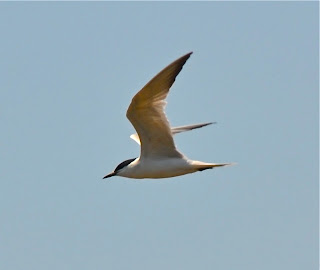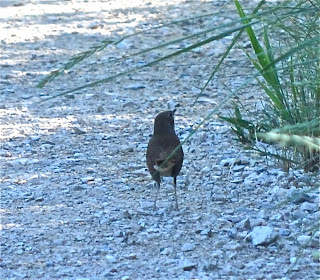The morning of July 7th was the morning of our final day in the Camargue National Reserve. My father and I had basically visited all the best spots of the reserve and we really didn't know where else to go. My dad then proposed we visit the town of Aigues-Mortes in the "Petite Camargue". As we drove through the small city (as it wasn't quite small enough to be called a "town"), I was discouraged because it didn't seem like there would be any suitable habitat to bird there. Then I noticed a large pond with several flamingos on it. I figured that birding this pond, lined with paths frequently used by joggers, dog-walkers and bikers, was better than driving around aimlessly and burning daylight. So we parked and began walking down. There weren't any birds of interest on the pond, just the regular stilts and gulls that abounded elsewhere. Suddenly this small white bird began bouncing over the small and dispersed flocks of the aforementioned. In noticed its black outer primaries and very stubby tail immediately and was able to determine that this was a Little Tern without even putting my binoculars up. This bird was fun because I had only seen it once before. But so far, that was the best bird. This pond was remarkably desolate. However, it wasn't that surprising when the surrounding highway, boisterous passersby and sound pollution were taken into account. As we approached the end of the trail, I was contented to find a few Common Shelducks sitting on a few islands, with their red-knobbed bills tucked into their wings. Suddenly I noticed a large gull movement in the sky above us. I immediately assumed these were some Yellow-legged Gulls, but they looked a little off. Curious as to what they were, I put my binoculars up and found myself looking at about 30 Mediterranean Gulls flying west. I read in my book that gulls and other shorebirds use some nearby ponds as feeding grounds, which must explain this relatively large movement.
 |
| One of the many Mediterranean Gulls flying over |
Then I noticed this smaller, daintier gull flying in the other direction. As I looked at it, the only feature that really stood out was its trailing white edge to its wings, which indicated that this was a Croicocephalus. I then tilted its head into my direction, and utter joy coursed through every vein in my body. It had a white head and a thin, all-black bill. It was my lifer Slender-billed Gull! This is a very localized species and breeder in Europe, and the Camargue National Reserve is one of their strongholds. Unfortunately, I wasn't ever really able to find out where their breeding grounds were, and they aren't reliable anywhere away from their breeding grounds, so I was ecstatic when I found this bird. This was one of my top-targets for my trip, and I was extremely happy to have found one.
This gull was the last notable bird I found at this location, so we decided to drive back to location visited the previous day: the marsh along the side of the road near the "Etang de Scamandre".
Once we arrived there, we found the usual crowd. There were fewer Whiskered Terns there that day, but there were more Gull-billed Terns than the previous day. It was quite amusing to see the plunge into the shallow ponds in this marsh. What several would do is dive headfirst towards the water, but right before hitting the water, they made a 90º switch and grazed the water with their bill, hoping to snatch a small fish. This technique did indeed prove fruitful as several did end up with their quarry.
 |
| Gull-billed Tern (notice the stubby black bill, and the black tip to the primaries) |
Another interesting bird to circle over us was a Eurasian Marsh-Harrier, a fairly common bird found throughout the marshlands of this reserve.
 |
| Eurasian Marsh-Harrier (notice the very broad wings and long tail, and the pale face and shoulders) |
As I scanned this area with my scope, I came across a very dark shorebird. At first I was puzzled, but then it faced me and I knew immediately what it is. Part of the reason why I was so confused by this bird is because usually they aren't present the first week of July in this location, not in high numbers anyways. This bird was a Spotted Redshank in alternate plumage, a gorgeous bird and a lifer. This bird was rather far away, so the only way to get identifiable shots was by digiscoping.
 |
| Spotted Redshank (notice the thin black bill with red at the base, and the overall dark brown plumage) |
The only other notable bird of that day was a European Roller that I spotted perched atop a lone tree along the side of the road.
 |
| European Roller (notice the brown back, and the light blue head and underparts) |
The following day, we were headed towards the Basque Country where we would spend the rest of our time in Europe. However, rather than driving straight there, I proposed we stop at this scenic location that is known to yield some highly sought-after alpine species: the "Cirque de Gavarnie", an amphitheater-like valley in the Pyrenees, that is known for its fantastic skiing in winter and its scenic hikes during the summer. We began walking up, and I was once again discouraged because of the myriad rowdy hikers that had clearly never seen a birder at hard work on his craft. We then noticed a smaller trail aside from the main trail that led to the forest. Though it didn't provide optimal viewing of the sky, which is what I wanted to pay attention to the most, it was nonetheless a thrilling walk, through a pine forest and over waterfalls, that yielded fantastic views of the typically higher-elevation Coal Tit, one the members of the ever-present European Paridaes.
 |
| Coal Tit (notice the the black bib and head, the white cheek, and grayish-black back with wing bars) |
Aside from the tit, this forest didn't yield very many species. So when we reached the main trail and could see the sky, I rejoiced. Yellow-billed Choughs became obvious, flying in remarkably large flocks and approaching the other hikers and picnickers at amazing proximity, probably in hopes of snagging a quick snack. Suddenly, I noticed this dark figure slowly soar above me. I put my binoculars up, and my heart skipped a beat. I immediately set up my scope at it and got an even better view at this awe-inspiring bird. It was a Lammergeier, every birder's dream sighting. This bird occurs throughout all the mountainous regions in Eurasia, from western Europe, to the Himalayas. However, in all of Europe and northern Africa, there are only an estimated 500 or so pairs that breed there. So this means that the European population is dispersed and sparsely populated, making it a very difficult species to see (which increases the excitement factor). I knew what this bird was immediately when I saw it, they have a very distinctive shape when soaring. The have very long and angled wings, and a very long, broad, wedge-shaped tail. In the right light, the buffy-beige underbelly was noticed, along with the darker shoulder parts on the underwings. Seeing this majestic bird was truly incredible experience that I know I won't be forgetting any time soon.
 |
| Lammergeier (notice the distinctive shape, the long and angled wings, and the buffy-beige underparts_ |
This concluded my brief visit to the "Cirque de Gavarnie", and despite the briefness, it was enough to really enjoy and appreciate the raw beauty of this pristine environment. There wasn't another place like this Cirque that I birded during my European vacation, so I was happy to make this little detour before heading off to the Basque Country, where I would spend the rest of my vacation.






































